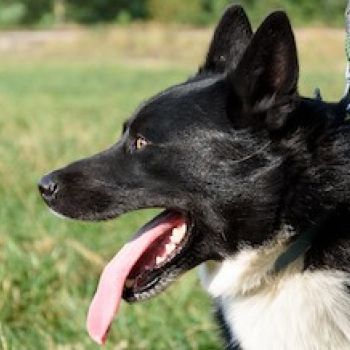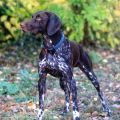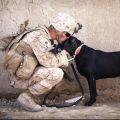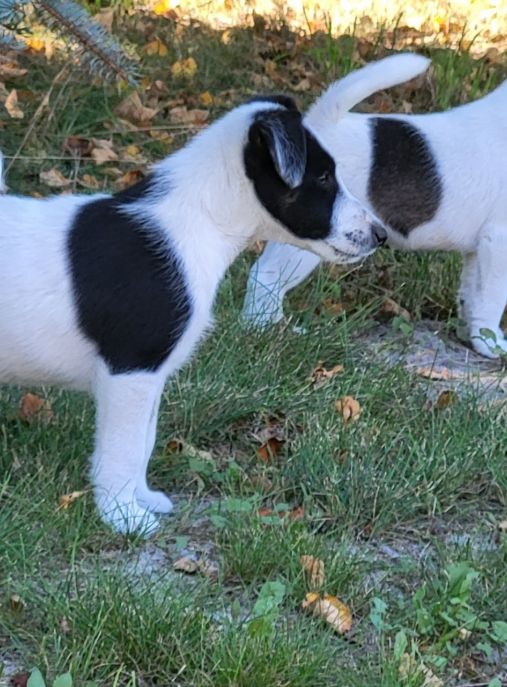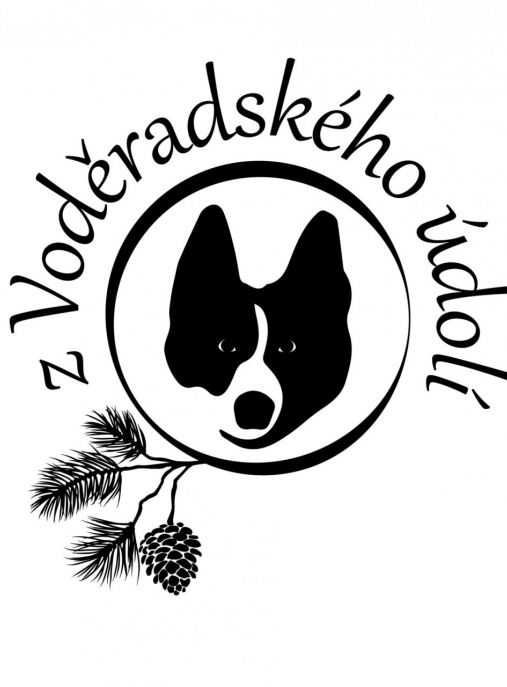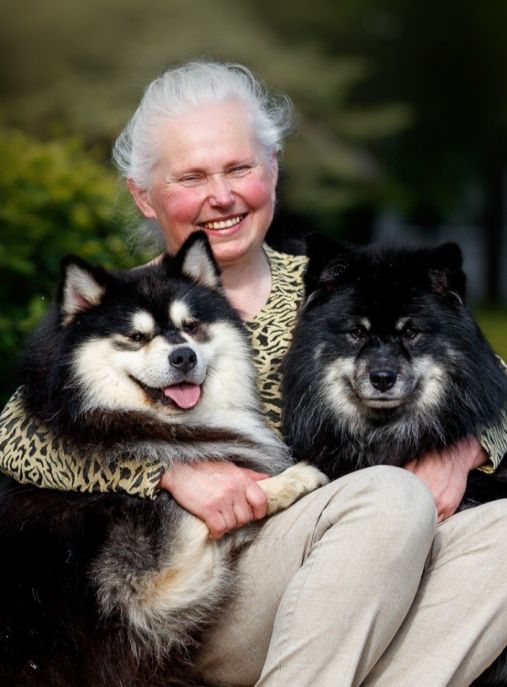The Karelian Bear Dog, also known as the Karjalankarhukoira, is a Finnish breed that is highly regarded for its hunting skills and ability to track and confront large game, including bears. This medium-sized dog is known for its strong build, agility, and fearless nature. With its striking black and white coat and alert expression, the Karelian Bear Dog is not only a formidable working dog but also a loyal and affectionate companion.
The history of the Karelian Bear Dog dates back several centuries, with its origins rooted in the region of Karelia, which spans across present-day Finland and Russia. This breed was primarily developed to assist in hunting large game, such as bears and moose. The Karelian Bear Dog's ancestors were likely a mix of local Finnish hunting dogs and Russian Laikas, which were known for their hunting prowess.
According to the FCI (Fédération Cynologique Internationale) typology, the Karelian Bear Dog belongs to Group 5, Section 2: Nordic Hunting Dogs. This group includes various hunting breeds that excel in tracking, hunting, and retrieving game. The Karelian Bear Dog is specifically classified under the Nordic Hunting Dogs section, which comprises breeds originating from the Nordic countries.
The Karelian Bear Dog is primarily bred for hunting purposes, particularly for tracking and confronting large game. Due to its fearless nature and strong hunting instincts, this breed is not recommended for inexperienced dog owners or those who cannot provide the necessary physical and mental stimulation. The Karelian Bear Dog thrives in an active environment where it can engage in regular exercise and participate in hunting or tracking activities.
In terms of physical characteristics, the Karelian Bear Dog is a medium-sized breed with a well-muscled body. Males typically stand between 21.5 to 24.5 inches (55-62 cm) at the shoulder, while females are slightly smaller, ranging from 19.5 to 22.5 inches (50-57 cm). The weight of an adult Karelian Bear Dog usually falls between 44 to 50 pounds (20-23 kg). This breed has a dense double coat, with a short, straight outer coat and a soft, thick undercoat that provides insulation in cold weather.
The life expectancy of a Karelian Bear Dog is typically around 10 to 12 years, although with proper care and a healthy lifestyle, some individuals may live longer. This breed is generally known for its robust health and resilience. However, like all dogs, they may be prone to certain health issues, including hip dysplasia, eye problems, and allergies. Regular veterinary check-ups, a balanced diet, and sufficient exercise are essential for maintaining the overall well-being of this breed.
One interesting fact about the Karelian Bear Dog is its distinctive hunting style. When tracking game, these dogs are known for their ability to trail silently, using their acute sense of smell to locate the target. Once the game is found, the Karelian Bear Dog will bark loudly to alert the hunter and keep the game at bay until the hunter arrives. This breed's tenacity, determination, and fearlessness make it an excellent choice for hunting in challenging terrains.
In addition to their hunting abilities, Karelian Bear Dogs can also make loyal and loving family pets. They are known to be good with children when properly socialized from a young age. However, their strong prey drive and protective instincts mean that they may not be suitable for households with small pets, such as cats or rabbits.
In conclusion, the Karelian Bear Dog is a remarkable breed with a rich history and exceptional hunting skills. Its strong build, agility, and fearlessness make it a formidable working dog, while its loyalty and affectionate nature make it a cherished companion. Whether as a hunting partner or a family pet, the Karelian Bear Dog brings a unique blend of strength, intelligence, and devotion to its role.
The Karelian Bear Dog is a remarkable breed known for its strong character and exceptional hunting abilities. Originating from the Karelia region of Finland and Russia, these dogs were primarily bred for hunting large game, including bears. With their distinctive black and white coat, sturdy build, and sharp senses, Karelian Bear Dogs are not only excellent hunters but also make loyal and devoted companions.
In terms of character, Karelian Bear Dogs are known for their independence and determination. They possess a strong prey drive and are highly focused when it comes to tracking and hunting. This breed is fearless and courageous, often displaying a remarkable level of bravery when facing dangerous situations. However, it is important to note that their hunting instincts are deeply ingrained, and they may not be suitable for households with small pets or animals.
Despite their strong-willed nature, Karelian Bear Dogs are incredibly loyal and affectionate towards their families. They form strong bonds with their owners and are known to be protective of their loved ones. This breed thrives on human companionship and requires plenty of socialization from an early age to ensure they grow up to be well-rounded dogs. They are generally good with children, but supervision is necessary due to their high energy levels and strong prey drive.
When it comes to training, Karelian Bear Dogs require a firm and consistent hand. They are intelligent and quick learners, but their independent nature can make them somewhat challenging to train. Positive reinforcement techniques, such as treats and praise, work best with this breed. Harsh training methods or physical punishment should be avoided as it can lead to fear or aggression.
Early socialization is crucial for Karelian Bear Dogs to ensure they are comfortable around other animals and people. Exposing them to different environments, sounds, and experiences will help them become well-adjusted adults. Obedience training is also essential to establish boundaries and ensure they respond to commands promptly.
Due to their hunting background, Karelian Bear Dogs have high exercise needs. Daily walks, runs, or vigorous play sessions are necessary to keep them physically and mentally stimulated. Engaging them in activities like tracking, scent work, or agility training can help channel their energy and provide them with a sense of purpose.
In terms of grooming, Karelian Bear Dogs have a dense double coat that requires regular brushing to prevent matting and remove loose hair. They shed moderately throughout the year and experience heavier shedding during seasonal changes. Bathing should be done as needed, and regular dental care, nail trimming, and ear cleaning are essential for their overall health.
In conclusion, Karelian Bear Dogs are intelligent, loyal, and courageous dogs with a strong hunting instinct. They require experienced owners who can provide them with firm yet positive training, plenty of exercise, and early socialization. With the right guidance and care, Karelian Bear Dogs can make wonderful companions for active individuals or families who appreciate their unique character and working abilities.
The Karelian Bear Dog is a strong, intelligent, and energetic breed that requires specific care to ensure their well-being and happiness. Here are some tips on how to care for Karelian Bear Dog dogs:
1. Exercise: Karelian Bear Dogs are highly active and need plenty of exercise to keep them physically and mentally stimulated. Daily walks, runs, or play sessions in a securely fenced yard are essential. Engaging them in activities like agility training or obedience trials can also help channel their energy in a positive way.
2. Mental Stimulation: These dogs are intelligent and thrive on mental challenges. Provide them with puzzle toys, interactive games, and training sessions to keep their minds sharp. Failure to provide adequate mental stimulation can lead to boredom and destructive behavior.
3. Socialization: Early and ongoing socialization is crucial for Karelian Bear Dogs. Expose them to various people, animals, and environments from a young age to ensure they grow up to be well-rounded and confident dogs. Regular visits to dog parks or enrolling them in obedience classes can aid in their social development.
4. Training: Start training your Karelian Bear Dog early and use positive reinforcement techniques such as treats, praise, and play. These dogs are independent thinkers, so patience and consistency are key. Avoid using harsh training methods as it can lead to fear or aggression.
5. Grooming: Karelian Bear Dogs have a dense double coat that sheds seasonally. Regular brushing, at least once a week, will help keep their coat healthy and reduce shedding. During shedding seasons, daily brushing may be necessary. Bathing should be done as needed, using a dog-specific shampoo to maintain their coat's natural oils.
6. Health Care: Regular veterinary check-ups, vaccinations, and preventive treatments for fleas, ticks, and heartworms are essential. Additionally, ensure your Karelian Bear Dog receives a balanced diet appropriate for their age, size, and activity level. Monitor their weight to prevent obesity, which can lead to various health issues.
7. Safety: Karelian Bear Dogs have a strong prey drive and may chase small animals. It's crucial to keep them on a leash or in a securely fenced area to prevent them from running off. Additionally, provide them with a comfortable and safe space indoors, away from hazards like toxic plants or chemicals.
8. Avoid Loneliness: Karelian Bear Dogs are social animals and can become anxious or develop behavioral issues if left alone for long periods. If you work long hours, consider hiring a dog walker or providing them with interactive toys to keep them occupied. Another option is to have a companion dog to keep them company.
9. Avoid Rough Play: While Karelian Bear Dogs are generally good with children, their high energy levels and strong prey drive may not make them suitable for households with very young children. Teach children how to interact with the dog respectfully and avoid rough play that may trigger the dog's instincts.
10. Avoid Overexertion: Karelian Bear Dogs have a strong work ethic and may push themselves beyond their limits. As an owner, it's important to monitor their activity levels and prevent overexertion, especially in extreme weather conditions. Provide them with plenty of water and shade during hot weather.
Remember, each Karelian Bear Dog is unique, and their care may vary slightly. By providing them with proper exercise, mental stimulation, socialization, and love, you can ensure a happy and healthy life for your Karelian Bear Dog companion.
The Karelian Bear Dog, a magnificent and robust breed, is known for its striking and distinctive coat color. The common color of Karelian Bear Dogs is predominantly black with white markings. This coloration creates a visually captivating contrast that accentuates the breed's strong and athletic physique.
The black color of the Karelian Bear Dog's coat is deep and rich, often appearing glossy and lustrous under sunlight. It covers the majority of the dog's body, including the back, sides, and tail. This dark hue serves as a natural camouflage, allowing the dog to blend seamlessly into its surroundings, particularly in dense forests and wooded areas where it was originally bred to hunt.
The white markings on a Karelian Bear Dog are strategically placed, adding a touch of elegance and uniqueness to their appearance. These markings typically appear on the chest, paws, tip of the tail, and sometimes on the face. The white patches are crisp and bright, providing a striking contrast against the black background. They can vary in size and shape, ranging from small spots to larger areas, giving each dog an individualized and distinct pattern.
The white markings on the chest often form a distinct and eye-catching pattern, resembling a bib or a shield. This feature is highly valued and sought after by breed enthusiasts and judges in dog shows. It adds a touch of regality and charm to the overall appearance of the Karelian Bear Dog.
The coat of a Karelian Bear Dog is dense and double-layered, providing excellent protection against harsh weather conditions. The undercoat is soft and insulating, while the outer coat is straight, coarse, and weather-resistant. This combination ensures that the dog remains comfortable and well-insulated in cold climates, allowing it to perform its duties as a hunting and working dog with utmost efficiency.
The black and white coloration of the Karelian Bear Dog is not only aesthetically pleasing but also serves a functional purpose. It allows the dog to be easily spotted by its human handler during hunting expeditions, ensuring effective communication and coordination between the two. Moreover, the contrasting colors make the dog highly visible to potential prey, enabling it to fulfill its role as a skilled and efficient hunter.
In conclusion, the common color of Karelian Bear Dogs is a striking combination of black and white. The deep black coat, adorned with bright white markings, creates a visually captivating contrast that enhances the breed's overall appearance. This coloration not only adds to the dog's beauty but also serves functional purposes, allowing it to excel in its hunting and working duties.
The Karelian Bear Dog, also known as the Karjalankarhukoira, is a robust and healthy breed with a relatively low incidence of genetic health issues. These dogs are known for their endurance, agility, and strength, making them excellent hunting and working companions. However, like any other breed, Karelian Bear Dogs are susceptible to certain health conditions. With proper care and attention, their overall health can be maintained at an optimal level.
One of the most common health concerns in Karelian Bear Dogs is hip dysplasia. This condition occurs when the hip joint doesn't develop properly, leading to discomfort, lameness, and arthritis. Regular exercise on soft surfaces, maintaining a healthy weight, and avoiding excessive jumping or rough play can help reduce the risk of hip dysplasia. Responsible breeders often perform hip evaluations on their breeding dogs to minimize the occurrence of this condition.
Another health issue that can affect Karelian Bear Dogs is progressive retinal atrophy (PRA). PRA is a degenerative eye disease that leads to vision loss and, in severe cases, blindness. Regular eye examinations by a veterinary ophthalmologist can help detect PRA early on, allowing for appropriate management and care.
Like many large dog breeds, Karelian Bear Dogs may also be prone to gastric dilatation-volvulus (GDV), commonly known as bloat. This life-threatening condition occurs when the stomach fills with gas and twists upon itself. GDV requires immediate veterinary attention and can be prevented by feeding multiple small meals throughout the day, avoiding exercise immediately after meals, and using elevated feeding bowls.
Maintaining good dental hygiene is crucial for the overall health of Karelian Bear Dogs. Regular brushing of their teeth, providing dental chews or toys, and scheduling professional dental cleanings can help prevent periodontal disease and other dental issues.
To ensure the overall well-being of Karelian Bear Dogs, it is essential to provide them with a balanced diet that meets their nutritional needs. High-quality dog food, preferably formulated for active breeds, should be fed in appropriate portions to maintain a healthy weight. Regular exercise is also vital to keep these energetic dogs mentally stimulated and physically fit.
Regular veterinary check-ups are crucial for early detection of any potential health concerns. Vaccinations, parasite prevention, and routine blood work are essential components of preventive care. Additionally, grooming should not be overlooked, as regular brushing helps maintain a healthy coat and allows for early detection of skin issues or parasites.
In conclusion, Karelian Bear Dogs are generally a healthy breed with a low incidence of genetic health problems. However, responsible ownership and proactive care are necessary to ensure their well-being. Regular veterinary check-ups, a balanced diet, exercise, dental care, and preventive measures can help maintain the health and happiness of these remarkable dogs.
The Karelian Bear Dog is a medium-sized breed known for its hunting abilities and strong physique. To ensure their overall health and well-being, it is crucial to provide them with a balanced and nutritious diet. Proper nutrition plays a vital role in maintaining their energy levels, promoting healthy growth, and preventing various health issues. Here is an extensive description of the nutrition requirements for Karelian Bear Dog dogs, along with advice on feeding and what to avoid.
Protein is an essential component of a Karelian Bear Dog's diet. It aids in muscle development, repair, and overall growth. High-quality animal-based proteins such as chicken, turkey, beef, and fish should be the primary source of protein in their diet. These proteins provide essential amino acids that are necessary for their overall health.
Fats are another crucial element in a Karelian Bear Dog's diet. They provide a concentrated source of energy and aid in the absorption of fat-soluble vitamins. Healthy fats like fish oil, flaxseed oil, and chicken fat should be included in their diet. These fats also contribute to maintaining healthy skin and a shiny coat.
Carbohydrates are a source of energy for dogs, but it is important to choose complex carbohydrates over simple ones. Complex carbohydrates, such as whole grains (brown rice, oats) and vegetables (sweet potatoes, carrots), provide a steady release of energy and are rich in fiber, aiding in digestion.
Fruits and vegetables are excellent additions to a Karelian Bear Dog's diet. They provide essential vitamins, minerals, and antioxidants. Blueberries, apples, spinach, and broccoli are great choices. However, it is important to avoid feeding them grapes, raisins, onions, and garlic, as these can be toxic to dogs.
Feeding guidelines for Karelian Bear Dogs vary depending on their age, weight, activity level, and overall health. Puppies require a higher amount of calories and nutrients to support their growth. As they grow older, their caloric needs decrease. Consult with a veterinarian to determine the appropriate portion sizes and feeding frequency for your dog.
Avoid overfeeding your Karelian Bear Dog, as they have a tendency to gain weight easily. Obesity can lead to various health issues, including joint problems and heart disease. Monitor their body condition regularly and adjust their diet accordingly.
It is important to provide fresh and clean water at all times. Hydration is essential for proper digestion, nutrient absorption, and overall health.
When choosing commercial dog food, opt for high-quality brands that use natural ingredients and have a good balance of proteins, fats, and carbohydrates. Avoid foods that contain artificial preservatives, colors, and fillers. Reading the ingredient list and understanding what each ingredient provides is crucial in making an informed decision.
Homemade diets can also be an option, but it is important to consult with a veterinary nutritionist to ensure that the diet meets all the necessary nutritional requirements.
In conclusion, a Karelian Bear Dog's nutrition should consist of high-quality proteins, healthy fats, complex carbohydrates, and a variety of fruits and vegetables. Avoid feeding them toxic foods, overfeeding, and low-quality commercial dog food. By providing a balanced and nutritious diet, you can help your Karelian Bear Dog thrive and maintain optimal health throughout their life.

